Jones & Horan Auction Team
Live Horological, Jewelry & Coin Auction
Sunday, October 2, 2016 at 11 am EST
No Reserves, No Buyer's Premium and No Sales
Tax
-
-
91. Waltham, model 1860/68, 16S KW model spring-detent
pocket chronometer mvt, assembly #1 stamped under dial and balance
cock, double-boxed as gimbaled deck watch, mvt signed "T J Pressey,
Boston, Mass" in script and block letters identical to model 1857
engraving, later engraved "No 1203" on plate, later silvered dial
incorrectly marked "F J Pressey, 1203," 44.08mm pillar plate diameter.
The first clue to identification was the balance cock with simple
tadpole regulator, first seen on model 1868 in its highest grade, and
the distinctive Waltham engraving. On analysis, the plate layout is
identical to model 1860 with the elimination of the portion of the
plate for the escape wheel, cut back to reveal the detent. What is
important is that the mvt is unaltered; this mvt was never intended to
have its typical lever escape wheel in its standard position, nor was
it ever provided with any pallet provisions. The plate is clean and
unaltered with only two holes for the detent, screw-hole and
locator-pin-hole. The cock (single-footed bridge) for the escape wheel
is original, as well as provision and recess for the escape wheel,
which is well away from the normal train layout. The fact that the
assembly number is stamped on both mvt and cock means that in all
likelihood the watch was experimental and intentionally produced by the
factory, with possibly only one ever produced, or a "one-off" made by
special order for a client. The pinned dial-foot positions are correct
for model 1860 and have marks from pin insertion. We believe Pressey
was the person who purchased the watch from Waltham and requested his
own private label, regardless of Waltham's reason for producing the
possibly unique article. The serial number engraved on the plate has
nothing to do with the original mvt, but was probably the contract
number for the party who made the conversion elements for placing in
service as a marine chronometer. Generally, collectors consider the
model 1860 to be KWKS, and model 1868 to be SW-LS, but it is clear from
data that there were both KW and SW mvts in at least the first run of
model 1868. See our further analysis under condition report to see why
this is significant.
Estimate: $5,000 - $10,000
Click Here For Condition Report
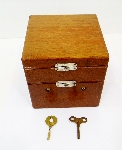



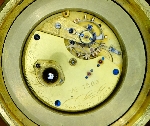
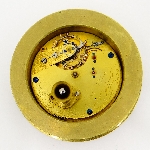


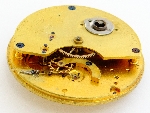
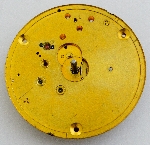

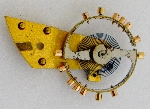
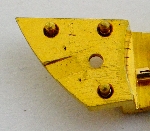
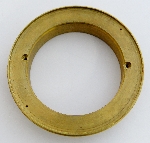

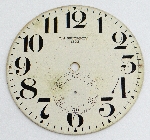
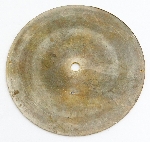 This Lot Sold On 10/2/2016 For $3,000
This Lot Sold On 10/2/2016 For $3,000
-
92. Gutkäss & Lange, rare miniature clock of thin
dimensions striking hours, 50mm x 67mm, under 20mm thickness from top
of hands to top of cock, the nickel balance cock of prototype Lange
shape, nickel lever platform escapement attached to brass plates, two
trains wound independently with key, set in back with key, signed WED,
blued hands, striking on single round gong, without number save for the
back of the dial, signed "Valat" with number 1036. The mechanism
possibly was integrated into a larger device, and the under-dial area
has further holes and circular recesses that defy explanation. A
fascinating early Lange timepiece from his partnership with Gutkäss
prior to the latter's death in 1845.
Estimate: $1,000 - $1,500
Click Here For Condition Report
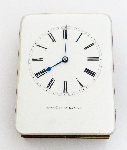
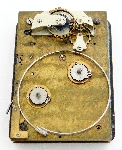
 This Lot Sold On 10/2/2016 For $1,100
This Lot Sold On 10/2/2016 For $1,100
-
93. Silver miniature grandfather's clock form desk or
vitrine clock in Dutch taste, English verge fusee mvt with scenic
painted dial, upper hinged-back bearing Paris hallmark for 1809-1819,
case-back bearing .833 Netherlands silver hallmark in use since 1814,
apparently with Paris import overstamp, the mvt held in inner English
case for another mvt, made integral with the bonnet, bearing London
hallmarks for 1780, mvt by Cha Dean, London, dial and remaining hand
Dutch, height 9 inches.
Estimate: $300 - $500
Click Here For Condition Report





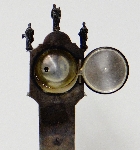

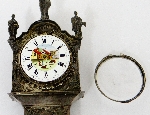
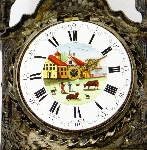
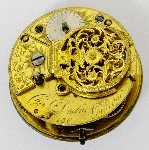
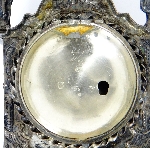 This Lot Sold On 10/2/2016 For $375
This Lot Sold On 10/2/2016 For $375
-
94. French silver desk clock case bearing Paris
hallmarks for 1809-1819, equipped with Barwise, London fusee duplex mvt
#3923 with fully capped escapement, DES, five-sparred balance, front
plate diameter just under 40mm, the case strut with London hallmarks
for 1890 apparently added upon import, the opposite strut with the
early Paris mark as well, height just under 5 inches.
Estimate: $200 - $300
Click Here For Condition Report
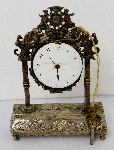
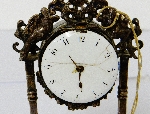

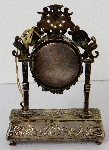
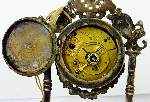 This Lot Sold On 10/2/2016 For $50
This Lot Sold On 10/2/2016 For $50
-
95. Louis XV style hanging clock with 18th century
Continental verge fusee mvt, 11 inches tall, dial diameter 51mm (2
inches), gilt cast brass case signed "Roy..." with indistinct
characters following, missing back cover, WED, one Louis XV style hand
plus replacement.
Estimate: $200 - $300
Click Here For Condition Report


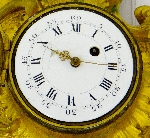

 This Lot Sold On 10/2/2016 For $100
This Lot Sold On 10/2/2016 For $100
-
96. Reproduction of triptych clock, cast brass frame
with enamel panels, now with mid-19th century cylinder mvt, machined
back with winding holes, mvt and cover can be aligned in any direction,
6 inches tall.
Estimate: $100 - $200
Click Here For Condition Report

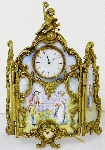



 This Lot Sold On 10/2/2016 For $120
This Lot Sold On 10/2/2016 For $120
-
97. Patek Philippe, Swiss high-grade mantle clock used
in sales showrooms or by dealers, three train, 8-gong, selection of
three tunes possible, Westminster, Whittington or St Michael's chimes,
with pendulum, 8-day. Height 16 inches, width 13 inches, depth 7
inches, dial diameter 7 inches. The movement is not the typical German
type seen in some examples, but a very fine grade with barrels looking
like early French clocks from the sides. The extent and variety of
handsome Patek Philippe showroom clocks is quite remarkable, from
simple quartz affairs to complex orrery types. The three-chime system
is quite rare among these, with optional silent position.
Estimate: $1,000 - $2,000
Click Here For Condition Report
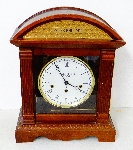
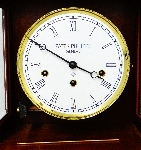





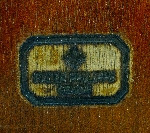
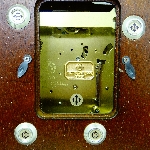
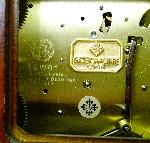
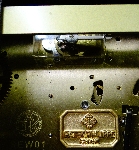

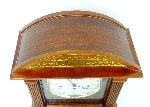

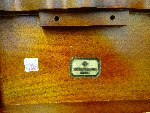
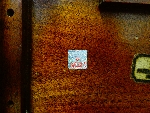 This Lot Sold On 10/2/2016 For $1,000
This Lot Sold On 10/2/2016 For $1,000
-
98. Chas Barrett, Shrewsbury (born 1728, died 1807),
English tall case clock with carved Jacobean style case, silvered dial,
brass spandrels, calendar, constant seconds, striking on bell, case
with carved scenes of men with spears confronting wild animals.
Estimate: $1,000 - $1,500
Click Here For Condition Report


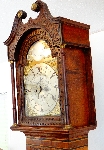

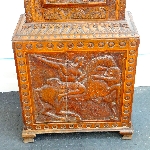
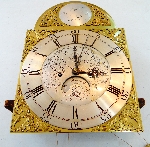
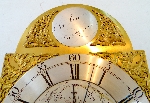
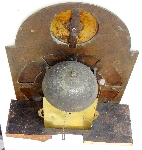
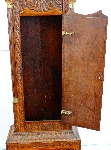


 This Lot Sold On 10/2/2016 For $2,600
This Lot Sold On 10/2/2016 For $2,600
-
99.
Attributed to James Collins, Goffstown, NH, time only mirror clock, ca 1820, weight driven, unique mvt design.
Estimate: $800 - $1,200
Click Here For Condition Report

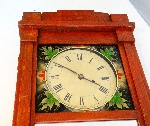

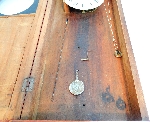
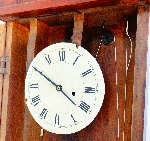

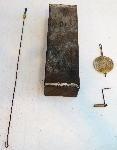 This Lot Sold On 10/2/2016 For $350
This Lot Sold On 10/2/2016 For $350
-
100. Congreve type rolling ball clock, time only with
three dials in line for hours, minutes and seconds, fusee driven,
unique escapement called "extreme detached escapement" by Congreve in
his original 1808 patent, the escapement beating 30 seconds, triggered
by the single ball striking a lever system at either end of its zigzag
trail down the incline, mvt in gilt brass with silvered dial chapters,
adjustable tripod base, shown in photo 90 degrees out of orientation,
should have two feet in front and one in back. The brass framed glass
top measures 10 inches cubed, the overall height just over 12 inches.
Only keeping a semblance of time after being adjusted to run, the clock
runs at its best when further adjusted so the ball travel is even
throughout its trip, and when it takes the same 30 seconds to go in
either direction. This popular novelty has been reproduced down to the
present day, making dating difficult.
Estimate: $750 - $1,000
Click Here For Condition Report
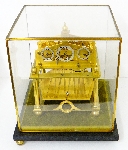
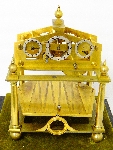
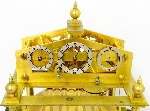
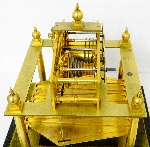
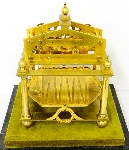
 This Lot Sold On 10/2/2016 For $425
This Lot Sold On 10/2/2016 For $425
-
101. Wm Sykes (William, Holbrook, Leeds, active from
1787), English tall case clock, 8-day, brass movement with calendar,
moonphase, constant seconds, striking on bell.
Estimate: $600 - $1,000
Click Here For Condition Report


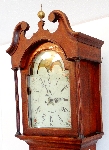

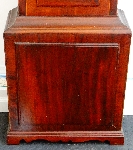
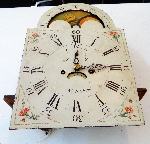
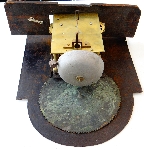
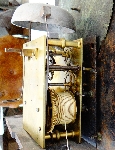

 This Lot Sold On 10/2/2016 For $650
This Lot Sold On 10/2/2016 For $650
-
102.
Waterbury Clock Co, weight-driven time only banjo clock, 43 inches tall, reverse painted glasses, painted dial.
Estimate: $150 - $250
Click Here For Condition Report

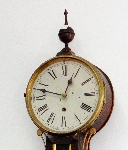





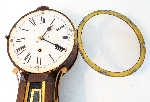
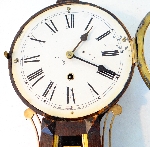
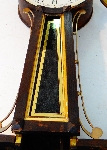
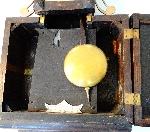
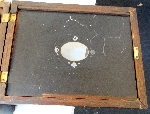 This Lot Sold On 10/2/2016 For $120
This Lot Sold On 10/2/2016 For $120
-
103. Singing Bird Box - Karl Griesbaum, Triberg, Black
Forest (founded 1905, continued in business until 1988), spring-loaded
return slide in front lifts the cover, releases bird that then turns
and sings until its cycle is complete, with bird-form key, the top
decorated with stars in striped field, the borders and sides with
beading, leaves and scrolls, the cover with scrolled leaves in relief,
measuring 5 x 4 x 2 inches high.
Estimate: $600 - $1,000
Click Here For Condition Report

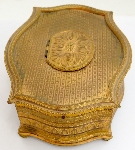
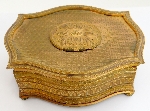
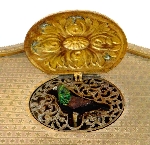
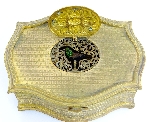
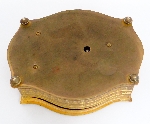 This Lot Sold On 10/2/2016 For $650
This Lot Sold On 10/2/2016 For $650
-
104. Polyphon music box playing 8-inch discs, ca 1890,
box 8.8 x 9.5 x 6 inches tall, together with sixteen discs. Invented in
1870, the device went into production in Leipzig, Germany under Firma
Brachhausen & Riesener in 1887, renamed Polyphon-Musikwerke in
1895, according to Wikipedia. Small-scale production of disks and
devices continues to this day, as the early devices have withstood the
test of time. The tone of the present device is exceptional, the tune
perfect. This device is wound with crank across the front of the box.
Play is activated by pulling out the stop on the front below the slot
for the crank. A lever on the right side should presumably switch
between continuous play and stopping at the cycle, but does not.
Estimate: $500 - $800
Click Here For Condition Report
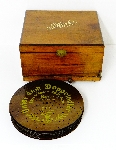
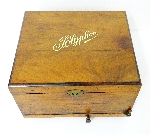
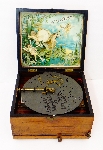


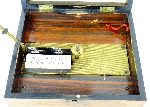

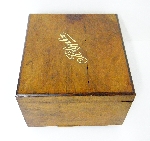
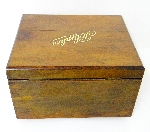
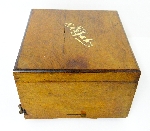
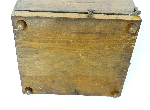 This Lot Sold On 10/2/2016 For $325
This Lot Sold On 10/2/2016 For $325
-
105. Swiss music box, 6-tune including at least one
Strauss waltz, marquetry inlaid cabinet measuring 17 x 8 x 5 inches
high, change-repeat switch, stop-play switch that stops immediately
rather than at the end of tune.
Estimate: $500 - $800
Click Here For Condition Report


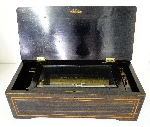


 This Lot Sold On 10/2/2016 For $325
This Lot Sold On 10/2/2016 For $325
-
106. Swiss music box, 4-tune ("Quatre Airs") including
at one march by Verdi, all tunes listed on label inside top, marquetry
inlaid cabinet measuring 16 x 6.5 x 4.5 inches high, nicely designed
cabinet folds out at left to reveal key-hole for fine old French iron
key winding the oversize square arbor, three unmarked switches below,
the first from the front being an absolute stop-play switch, the second
allowing continuation to end of tune or continuous play, and the third
apparently for repeating the same tune, but resisting operation.
Estimate: $400 - $700
Click Here For Condition Report


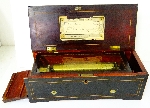



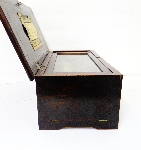
 This Lot Sold On 10/2/2016 For $475
This Lot Sold On 10/2/2016 For $475
-
107. Polyphon music box playing 6.5-inch discs, ca
1900-1920, box 8 x 7.5 x 5 inches tall, together with thirty-five
discs. Invented in 1870, the device went into production in Leipzig,
Germany under Firma Brachhausen & Riesener in 1887, renamed
Polyphon-Musikwerke in 1895, according to Wikipedia. Small-scale
production of disks and devices continues to this day, as the early
devices have withstood the test of time. The tone of the present device
is excellent, the tune sharp in places. This smaller version is wound
with crank across the side of the box. Play is activated by pulling out
the stop on the front below the latch, and will run continuously until
pushed back in, when it will stop nicely at the end of the cycle.
Estimate: $300 - $500
Click Here For Condition Report

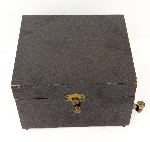

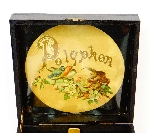
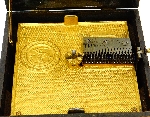
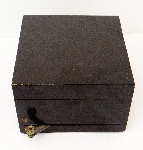
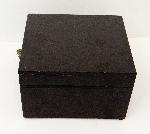
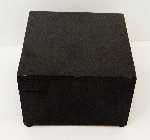
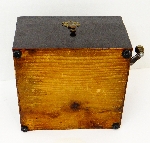 This Lot Sold On 10/2/2016 For $100
This Lot Sold On 10/2/2016 For $100
-
108. Leica, DRP, Ernst Leitz, Wetzlar, camera #224070
in leather-cased kit with additional lens #334035, zoom lenses #245740
and #455739, other lenses, filters and objectives, extension tube,
Leica-Motor base #656, along with tripod and many accessories,
Leica-related paperwork and substantial 1956 edition of Leica manual.
Purchased and added to on trips to postwar Germany over the years. The
DRP designation confirms production of the camera during the Third
Reich, after the war becoming DBP (Deutsches Bundespatent). As Leica
employed many highly skilled workers of the Jewish faith, Ernst Leitz
II began creating job assignments outside of the Reich starting in
1933, and created what came to be known as the "Leica Freedom Train"
which intensified in 1938 after Kristallnacht, lasted until border
shutdown in 1939, and remained secret until years after WWII, the
family never seeking notoriety for their heroic acts. This fascinating
story is reviewed by Wikipedia, with several sources for further
reading.
Estimate: $1,000 - $2,000
Click Here For Condition Report

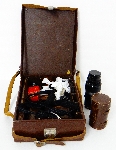
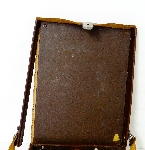

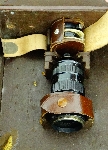



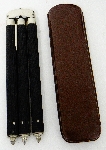 This Lot Sold On 10/2/2016 For $850
This Lot Sold On 10/2/2016 For $850
















 This Lot Sold On 10/2/2016 For $3,000
This Lot Sold On 10/2/2016 For $3,000


 This Lot Sold On 10/2/2016 For $1,100
This Lot Sold On 10/2/2016 For $1,100










 This Lot Sold On 10/2/2016 For $375
This Lot Sold On 10/2/2016 For $375




 This Lot Sold On 10/2/2016 For $50
This Lot Sold On 10/2/2016 For $50




 This Lot Sold On 10/2/2016 For $100
This Lot Sold On 10/2/2016 For $100





 This Lot Sold On 10/2/2016 For $120
This Lot Sold On 10/2/2016 For $120















 This Lot Sold On 10/2/2016 For $1,000
This Lot Sold On 10/2/2016 For $1,000











 This Lot Sold On 10/2/2016 For $2,600
This Lot Sold On 10/2/2016 For $2,600






 This Lot Sold On 10/2/2016 For $350
This Lot Sold On 10/2/2016 For $350





 This Lot Sold On 10/2/2016 For $425
This Lot Sold On 10/2/2016 For $425









 This Lot Sold On 10/2/2016 For $650
This Lot Sold On 10/2/2016 For $650











 This Lot Sold On 10/2/2016 For $120
This Lot Sold On 10/2/2016 For $120





 This Lot Sold On 10/2/2016 For $650
This Lot Sold On 10/2/2016 For $650










 This Lot Sold On 10/2/2016 For $325
This Lot Sold On 10/2/2016 For $325





 This Lot Sold On 10/2/2016 For $325
This Lot Sold On 10/2/2016 For $325







 This Lot Sold On 10/2/2016 For $475
This Lot Sold On 10/2/2016 For $475








 This Lot Sold On 10/2/2016 For $100
This Lot Sold On 10/2/2016 For $100








 This Lot Sold On 10/2/2016 For $850
This Lot Sold On 10/2/2016 For $850